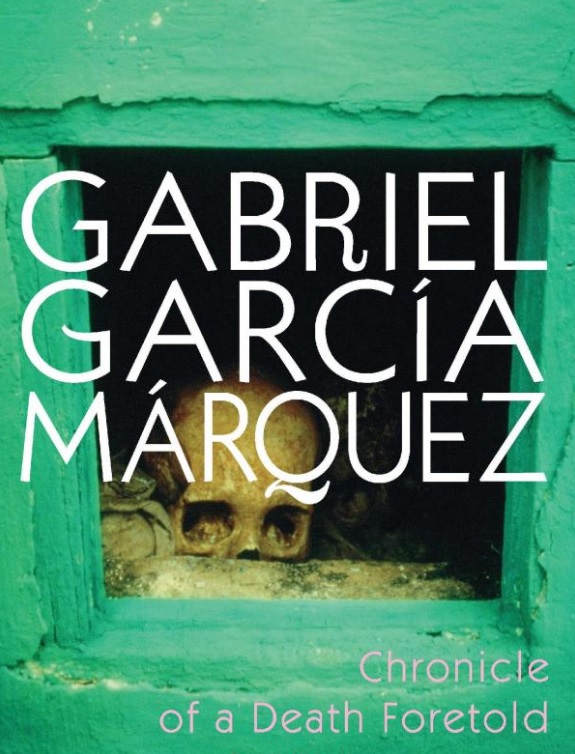A book review of Chronicle Of A Death Foretold by Gabriel García Márquez, translated from the Spanish by Gregory Rabassa

Publisher: Penguin Random House India, No. of Pages: 122
It’s nothing like a conventional chronicle. But it’s certainly a narrative that is being foretold, a story that unfurls ahead of its time. The readers are made aware of the climax—the death, or the honor killing, of Santiago Nasar—in the first sentence of the novella Chronicle Of A Death Foretold by Gabriel García Márquez, translated from the Spanish by Gregory Rabassa.
A skillful craftsman of non-linear narratives, García Márquez, in his signature move, makes time travel in gyrating whirlpools in this novella which was first published in 1981. The eye of the storm—the incident central to the plot—is transfixed onto the readers: Santiago Nasar’s brutal killing. And yet, the storm around it and the debris it carries are to be revealed only later, eventually, as time and memory spiral around it.
From the onset, the readers are given the knowledge of the murder, where it took place, why it took place, and who committed it. But still, the veil and nudge of mystery percolate through the narrative as the readers are egged to discover the hows of such a strange happening. This strange happening—the series of peculiar coincidences that lead to the killing of Santiago Nasar—pushes itself to the realms of magic realism that had broken the conventions of writing and reading during the twentieth-century Latin American Boom. When one reads the novella today, its breathtaking beauty is no surprise as one is left with the longing of reading it again as soon as the last sentence ends on a dramatic note, like a scene from a Greek play, where Santiago Nasar falls “on his face in the kitchen.” This death, the tragic fall, is a piece of information that is reiterated several times in the narrative, yet the anticipation of its inevitability and the nature of the tragedy as it unfolds hook the readers to its plot, while also providing the comfort of lucid poetic symbols that create the atmosphere of the tragedy.
The omniscient narrator mostly speaks in the third person plural, and only seldom shifts to the first-person singular ‘I’, giving the readers only partial information about the narrator. In doing so, the anonymous narrator establishes himself as the “chronicler” of the murder, assuming the identity of a detective trying to dig up evidence of a past crime, twenty-seven years after it had been committed. But as the narrator begins to re-construe the story of Santiago Nasar’s death, he seems to realize the futility of chronicles itself as he discovers the twisted role of memory in the remembrance of events and emotions. Hence, the “chronicle” becomes “foretold” with the end in the beginning and the several beginnings that make up the end. The narrator, in trying to put together a “chronicle”, realizes the varied fatal flaws of history and its insistence to be unilinear and objective. The telling of a history that conjures itself from bureaucratic records and fits itself into the boxes of facts, presenting one single truth, is countered through the symbol of the investigating committee’s brief, the only official document used in the reconstruction of the story of Santiago Nasar’s death. The brief showed many misconceptions and gaps in the creation of history, some of them being blatant discrepancies in evidence and testimonies, the overbearing influence of the prevailing prejudices, the absences and abrupt ends of a narrative, and most importantly the magistrate’s “marginal notes” written with poetic wisdom. Eventually, the narrator discovers that the story involves many other dimensions of experiences and emotions that the brief could not contain due to its strictly objective and rational character. Hence, the journalistic tone with which the narrator begins his investigation seems to lose its vigor as it moves along and finally assumes a pitch that acknowledges the power of subjective memory.
All readers of García Márquez would be familiar with his various poetic and philosophical moorings on memory, remembrance, and forgetting in his works such as One Hundred Years Of Solitude and Love In The Time Of Cholera wherein he attempts to almost lyricize the role of memory, making a statement about its subjective quality. This is perhaps owed to his deep-seated desire to preserve the memories of oppression of his people despite the forces of power actively trying to erase them, by inculcating the practice of forgetting. Thus, Chronicle Of A Death Foretold also follows such a tradition and seems to imply that the lawlessness, brutality, and gore of the Iberian invasion in Latin America broadly, and García Márquez’s homeland, Colombia specifically, is not to be forgotten: It is to be chronicled. And certainly not by following the strict rules of objectivity and fact collection but through the frazzled subjectivity of memory, rendering ‘history’ an alternative meaning. This is apparent when the narrator says, “…I returned to this forgotten village, trying to put the broken mirror of memory back together from so many scattered shards.”
This “forgotten village” makes one reminiscent of the seminal text that is known to influence García Márquez’s writings greatly: Juan Rulfo’s Pedro Paramo (1955). The ghost town in Rulfo’s imagination, as constructed through the memory of its beings, finds its parallel in how Santiago Nasar’s death (or honor killing) is re-constructed through the remembered accounts of the inhabitants of the “forgotten village”. Thereby, the telling of alternate histories that are at risk of extinction seems to crawl under the words as they string together to form the plot. Later, in the novella, when the narrator looks for the lost brief of the investigation in the Palace of Justice in Riohacha, he says, “There was no classification of files whatever and more than a century of cases were piled up on the floor of the decrepit colonial building…,” indicating that colonial bureaucracy had buried multitudes of such unresolved mysteries, and this particular history was only one among the many strange happenings that may be lost.
And of course, when one picks up shards of broken mirrors, some images are reflected magically to create optical illusions. These optical illusions, the magic realist stylistics, are rampant in Chronicle Of A Death Foretold as conflicting versions of each of the character’s recollections befuddle the perception of one truth as the readers are constantly left to wonder whether the weather was “funereal” or “radiant” on the morning that Santiago Nasar was killed. The motif of rain is used poignantly as it appears as a “gentle breeze” in Santiago Nasar’s dream the night before his death and every character, including the narrator, had differing versions of whether it had rained on the morning of his death. Some couldn’t simply remember, and to some, it seemed that it may have rained while others were certain that it hadn’t. Through this motif, the narrator marvelously brings forth the illusory nature of memory and remembrance. He concedes to his lack of objectivity, admitting that his own memory is susceptible to decay when he says, “I had a very confused memory of the festival before I decided to rescue it piece by piece from the memory of others,” thus indicating that this is an exercise of remembering for the narrator as well. It is almost an attempt to find the language to “chronicle” a memory, a trauma, that suffers the risk of forgetting, and hence is deprived of any justice.
The crime that calls out for justice is the honor killing of Santiago Nasar by the Vicario twins, as Santiago Nasar had allegedly been accused of ‘taking’ the virginity of their sister, Angelica Vicario, who was returned on the night of her wedding by her husband, Bayardo San Roman. Meanwhile, the multiple layered traumas of the different characters in the novella revolve around this central crime. Angelica Vicario, the abandoned wife, whose honor was placed in her virginity, was shamed and ostracized to an extent that she believed that her unconditional devotion to loving her husband through means of sending uncountable letters which never saw a response was her only means of emancipation. Then, there’s the trauma of Santiago Nasar’s mother, Placida Linero, whose folly and inability to foresee his son’s danger haunted her after his death, especially her last move of failing to see his son and closing the door, allowing the killers to strike their fatal blows. Overall, Santiago Nasar’s murder, a public event, is also a collective trauma suffered by the entire village as almost everybody had knowledge that he would be killed. There were enough premonitions but it still happened, and hence the village and all its inhabitants suffer from the guilt of being complicit in the crime in their own subjective realities. Santiago’s father’s mistress, Victoria Guzman, despite knowing that he was going to be killed when she met him in the morning, chooses to withhold the information from him. It was not just his father’s spite that Victoria Guzman unloads on him, it was also the malice of Santiago Nasar constantly sexually assaulting her young daughter, Divina Flor. It is hinted several times that Victoria had secretly wanted him killed, representing a mother’s rage against her daughter’s abuser. Additionally, the friends of Santiago Nasar, including the narrator, also suffer from helplessness and regret at their inability to forbid their friend’s death. The most amusing fate befalls the Vicario twins: they want to be stopped from committing the act, but the confusion of a ritualistic event, the bishop’s arrival, meddles with their plans. It is almost as if they had no choice but to slice up Santiago Nasar as society imposes upon them the responsibility to protect the ‘honor’ of their sister, a crime that ate their conscience but forbade them from showing any remorse or repentance. Multiple traumas ooze and merge into each other, creating an ocean of suffering that screams for justice.
Interestingly, whether Santiago Nasar was responsible for the act he was punished for is not clear to the readers and remains a mystery, like many other small discrepancies that do not find any resolution. The narrator, by describing the murder’s brutality and gore, not only establishes the barbarity of the act but also asserts the absurdity of honor killing by establishing it as a crime that is motivated but never clearly justified.
Therefore, a repository of various traumas, the uncertainties of life, the fatal flaws of history, and the stolid face of death and decay, bind this “chronicle” that moves in a whirlpool of time. By the end of the novella, the “chronicle” that is “foretold” becomes a prophesy: the readers are made aware that sometimes imminent danger or death is inevitable but humanity fails to regulate it as the society is clouded with apathy, prejudices, and a veil of power that shrouds memory. For us, who are living in the twenty-first century, struggling with remembering as our memory becomes a bit strained with each passing day, Chronicle Of A Death Foretold is a foreboding, one that has been “foretold” a century earlier, about the struggles of memory that we face today.
Also, read an excerpt from a Bengali science fiction written by Dipen Bhattacharya, translated into English by Chirayata Chakraborty, and published in The Antonym:
Follow The Antonym’s Facebook page and Instagram account for more content and exciting updates.


























0 Comments